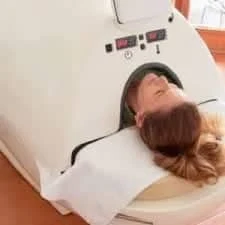Hyperthermia Therapy for Cancer Treatment.
Overview
Hyperthermia
therapy is a cancer treatment therapy, that elevates the temperature of part
or the whole body as much as 113 °F for a distinct period of time to destroy
cancer cells and minimize tumors. This technique can also be used more
efficiently for other treatments, such as chemotherapy and radiation
therapy.
Hyperthermia therapy for cancer treatment may be an option for patients who are not healthy
enough to get into surgery or the tumor that is too hard to reach for surgery.
In this editorial, we are going to converse on some basic questions about Hyperthermia therapy for Cancer Treatment.
Hyperthermia therapy for cancer treatment
What is hyperthermia therapy and what temperature kills cancer cells?
Hyperthermia is the new type of therapy for cancer treatment, in which body tissues that have cancer tumors expose to heat as high as 113 °F to help tumor damage and kill the tumor with no or little harm to normal body tissue. Research shows that elevated temperature of the body can destroy or kill the cancerous cell with minimal tissue injury.
Other, names
for this heat therapy are thermotherapy and thermal therapy. It is not
extensively available yet.
Hyperthermia may also be used as a supportive therapy with other treatments like chemotherapy or radiation therapy.
Who need this therapy of heat?
With the
following conditions, patients may take advantage of this heat therapy.
- The tumor located near the surface of the skin is small in size.
- For patients, who have serious health issues, doctors suggest they avoid going into surgery.
- Tumors are located in the cavity of the body.
- The tumor presented in deep that can’t be treated by surgery
The success rate of hyperthermia cancer therapy
Hyperthermia can be used as a supportive therapy with chemo and radiation therapies.
According to Duke University Researches in 2010, health specialists found that the addition of hyperthermia to radiation therapy for breast cancer formed a 65% response rate compared with a 42% rate for radiation alone.
Does hyperthermia therapy available worldwide?
In general,
Hyperthermia therapy is not common worldwide due to ongoing studies and
clinical trials. However, it’s widely available in the U.S.
Some forms of hyperthermia therapy are more common than others, like Local therapy, such as RFA (Radio frequency ablation) and regional therapies like HIPEC (Hyperthermia intra-peritoneal chemotherapy) are more common than whole-body hyperthermia.
Types of hyperthermia therapy
- Local hyperthermia
- Regional hyperthermia therapy
- Whole-body hyperthermia therapy
1. Local hyperthermia therapy
Local hyperthermia
is a targeted therapy in which heat targets a small area such as a tumor. The
heat source is energy such as electromagnetic waves, radio waves, or ultrasound
waves. This is most effective for
- A tumor that is too deep and can’t be removed by surgery
- The tumor is located in the small cavity of the body
- Tumors small in size and underneath the skin
Examples of local hyperthermia therapy
Examples of
local hyperthermia therapy comprise
- LITT (Laser interstitial thermal therapy) is used for the tumor presented in deep.
- RFA (Radiofrequency ablation) is used for tumors presented in the lungs, kidneys, and liver.
2. Regional hyperthermia:
This form of
Hyperthermia therapy can target large areas of the body, such as limbs,
cavities, and organs. Classically this technique gives good results with the
combination of chemotherapy.
Techniques
that are used in regional hyperthermia contains
- Deep tissue therapy
- Regional perfusion
- Hyperthermia intraperitoneal chemotherapy (HIPEC), also known as continuous hyperthermic peritoneal perfusion (CHPP)
a. Deep tissue therapy
In this
technique of regional hyperthermia therapy, high-energy waves are used from
outside of the patient's body at organs in a cavity, such as a cervix or a
bladder.
b. Regional perfusion
This technique
aims to fill the whole limb or cavity with heat. The doctor may take a decision
to remove the patient’s blood, heat it and after that put it back in the body,
or maybe, he packs a body part with heated chemotherapy.
- The regional perfusion technique is used to treat skin cancer (melanomas) or cancer which starts in the soft tissues or bones (Sarcoma).
- Hyperthermia Intra-peritoneal chemotherapy (HIPEC) OR Continuous Hyper-thermic Peritoneal Perfusion (CHPP)
- HIPEC is used for the treatment of cancers located in the peritoneal cavity. This cavity is the part of the abdomen that contains the liver, intestine, and stomach. Healthcare providers heat the chemotherapy and pump it into the patient’s abdomen, but they take the decision either this procedure should be followed after or during the surgery.
3. Whole-body hyperthermia therapy
If cancer
spreads throughout the body of the patient (called metastatic) the health
providers decide to follow the whole-body hyperthermia technique.
In this type of
Hyperthermia therapy patients are allowed to be wrapped up in hot water
blankets or placed in a thermal chamber that elevates the body temperature to
107 or 108 °F for a short period of time.
Some patients
may receive fever-range, whole-body hyperthermia. It will be a controlled,
short fever that can trigger the patient’s immune system to fight against
cancerous cells.
Editor's picks
Psyllium husk powder sources, benefits, side effects
 |
| whole-body hyperthermia therapy |
Hyperthermia procedure details
There are some
protocols to follow before the therapy, are following
1. Testing and questioning follow up
Before hyperthermia therapy, a patient
healthcare provider may also
- Give instructions about drinking and eating before the therapy.
- Ask the patient to stop taking certain medicines before the treatment. These may medications may include those that thin the blood, which may affect the therapy performance or results.
- Perform imaging examinations like MRI, CT scan, or ultrasound. These examinations can pinpoint the exact location of the tumor that needs treatment. And also assist reduce the risk of damage to healthy tissues nearby the tumor.
- Request the patient to get the blood test done in order to make sure the patient is healthy enough to get hyperthermia therapy.
- This is a suggestion for the patient that on the day of treatment he or she plans for someone to drive him home after therapy.
2. Selection of form of therapy
A panel of
healthcare providers decided on what temperature should be used during therapy.
They also set
strategies for hyperthermia therapy to determine what kind of treatment the
patient should be received. For example, some patients get this therapy gone
after immediately radiation therapy whereas others have the treatment, such as
HIPEC (Hyperthermia Intra-peritoneal chemotherapy), at the same time as
surgery.
Sometimes a patient needs a procedure before regional hyperthermia therapy to implant a port and a catheter. The catheter is a thin flexible tube that goes directly into a body cavity like a patient’s abdomen. It connects to a port, which is a small tube under the patient skin. Healthcare providers can deliver heated chemo right into the port. Then one needle stick is needed.
What happens during hyperthermia therapy?
All forms of
hyperthermia treatment use specialized thermometers to monitor the patient’s
body temperature. Therapy times may range anywhere from 10 minutes to many
hours. The technique healthcare providers deliver the treatment depends on the
type of patient need.
What happens during local hyperthermia?
During the
procedure of RFA (Radio Frequency ablation), or LITT (Laser interstitial
thermal therapy), the healthcare provider heats the tumor directly. In this
procedure, they insert a needle-like probe into the skin directly. Once the
probe reaches the tumor, its tip releases the electric current and heats the
tumor. The patient may be given anesthesia during the procedure.
But for external therapy, the medical panel may use a machine to aim to release high-energy waves toward the tumor. This procedure is non-invasive, so doesn’t require any cut (incision) in the patient’s skin. A patient may be given local anesthesia, so it will not be a painful procedure.
What happens during regional hyperthermia therapy?
In Regional hyperthermia therapy limbs or cavities of
the body fills with very strong chemo. Most patients received the treatment
during surgery and need general anesthesia.
For the duration of limb perfusion, the patient
received heated chemotherapy through a catheter in the limbs. This technique
needs surgery because the patient’s blood isolation in the limbs from
throughout the body is essential.
During HIPEC (Hyperthermia Intra-peritoneal chemotherapy) medical panel fills the patient’s abdomen with heated chemo after they remove tumors. The chemo kills the remaining cancerous cells.
What happens during whole-body hyperthermia therapy?
In this procedure medical panel gradually increases
the patient’s body temperature to about 104 F°. They maintain that temperature
for at least six hours. After that, they slowly bring the body temperature back
down to normal.
Healthcare providers may follow heat therapy with chemotherapy through a catheter. The patient will be under light sedation so, he will be relaxed and sleepy, but at rest respond to stimuli.
What happens after hyperthermia
After hyperthermia therapy patient may go home at the same day (called
outpatient procedure) of the treatment if surgery is not done. But if it is
combined the surgery, patient will have to stay in the hospital overnight to
several days. These are the standard protocols follows for recovering from
surgery.
Depending on the type of therapy received, patient might be able to
recommence his usual activities in few days, but recovery from a surgery may
take some weeks.
Medical panel may prescribe some pain killer medications as patient recover, and may order periodic blood tests or imaging exams.
Editor's picks
Intraductal papillary mucinous neoplasm (pancrease cancer)
Mono rash pictures, symptoms, diagnosis, treatment
Nose picking can cause Alzheimer's or dementia
Risk and benefits
What are the risks of hyperthermia therapy?
Risks may include
- Burns or blister on the skin
- Bleeding
- Diarrhea
- Blood clots
- It may damage muscles and nerves
- Nausea and vomiting
- Tissue damage or swelling
- Pain at the site of treatment
- Infection
The Whole-body hyperthermia therapy can cause the problems with heart and blood vessels or other organs, but it’s rarely happens.
What are the benefits of hyperthermia therapy?
May include
- Minimizes the damage of the surrounding tissue while, treating the tumor only.
- Improves other treatment or support the other therapies like chemotherapy or radiation therapy. Hyperthermia treatment can make them more effective.
- Hyperthermia therapy has the ability to treat tumors that can’t be treated or remove by a surgery.
- Hyperthermia may be the possible treatment for the patients who are not healthy enough for surgery.
Recovery and outlook
What is the long-term outlook after hyperthermia?
Hyperthermia
therapy is quite new way of cancer treatment and still under investigation in
clinical trials like many others treatments. Research, is ongoing to determine
if this technique improves long-term outcomes for the cancer patients
Some studies reveal that heat therapy, when hyperthermia therapy combined with other cancer treatments like, chemo therapy, the size of tumor reduces. But still, it’s not clear yet if, this treatment increase survival rates in patients who get the hyperthermia therapy.
Conclusion:
Hyperthermia therapy is the new technique of cancer treatment in which,
heat is used to kill or destroy cancerous cells and shrink a tumor. It can also
make other cancer treatment more effective, for example, radiation therapy and
chemotherapy.
This is quite new technique of cancer treatment, so it is can’t be considered as a standard cancer treatment. This is an advice, the people who are considering this therapy for their cancer treatment, please discuss with your healthcare providers about hyperthermia to find out if it could be a treatment option.





.jpg)
Post a Comment